Rotations in football have come into limelight in the modern game more than ever before. As we begin to view formations as dynamic interconnections between groups of players in specific phases of attacking organisation rather than rigid structures, we become more aware of the significance that specific movements by players can have as we progress up the pitch, in exploiting spaces as well losing opposition markers.
The use of rotations in football was first seen with teams that implemented Total Football, such as the Dutch side of Rinus Michels. Rotations became commonplace with Johan Cruyff’s Ajax and Barcelona sides using intricate positional tactics to gain various forms of superiority constantly. Marcelo Bielsa has been studied extensively for his successful implementation of rotations, most recently with Leeds United in a physically demanding league like the Championship. More teams such as Holstein Kiel’s U19s are innovating the use of rotations in build-up involving their deepest players pushing courageously higher into the midfield.
Tactical analysis of various teams help us visualise these rotations easily after a game. But how can we coach the fundamentals behind the movements that involves a specific rotation? How does a rotation align with our principles of play? Most importantly, how can we implement rotations in our coaching sessions without them being passive coordinated movements of players, and rather an active decision-making process of finding and exploiting spaces while maintaining the objectives of our game model? Futsal, the indoor 5-a-side format of the game can help us understand the concept of rotations better and give us ideas that we can borrow.
Comparing football and futsal
Futsal is played on a small court on an indoor surface where the spaces are very tight, and the players have very less time on the ball. In most cases the game involves a 4v4 scenario of numerical equality with the outfield players. In football however, the pitch is much bigger. The spaces can be wide or tight depending on the density of players in certain parts of the pitch and how teams chose to play. We seldom see a 10v10 scenario of numerical equality and rather, the game gets broken down into smaller games (3v2, 4v4, etc.) in different phases of play. Closing down all players in a man-oriented press takes much longer than in futsal and hence, there is always a ‘free-man’ to exploit giving rise to infinite scenarios of overloads and underloads. Below is an example of a typical futsal rotation by FC Barcelona Futsal using three channels that I will elaborate further on.
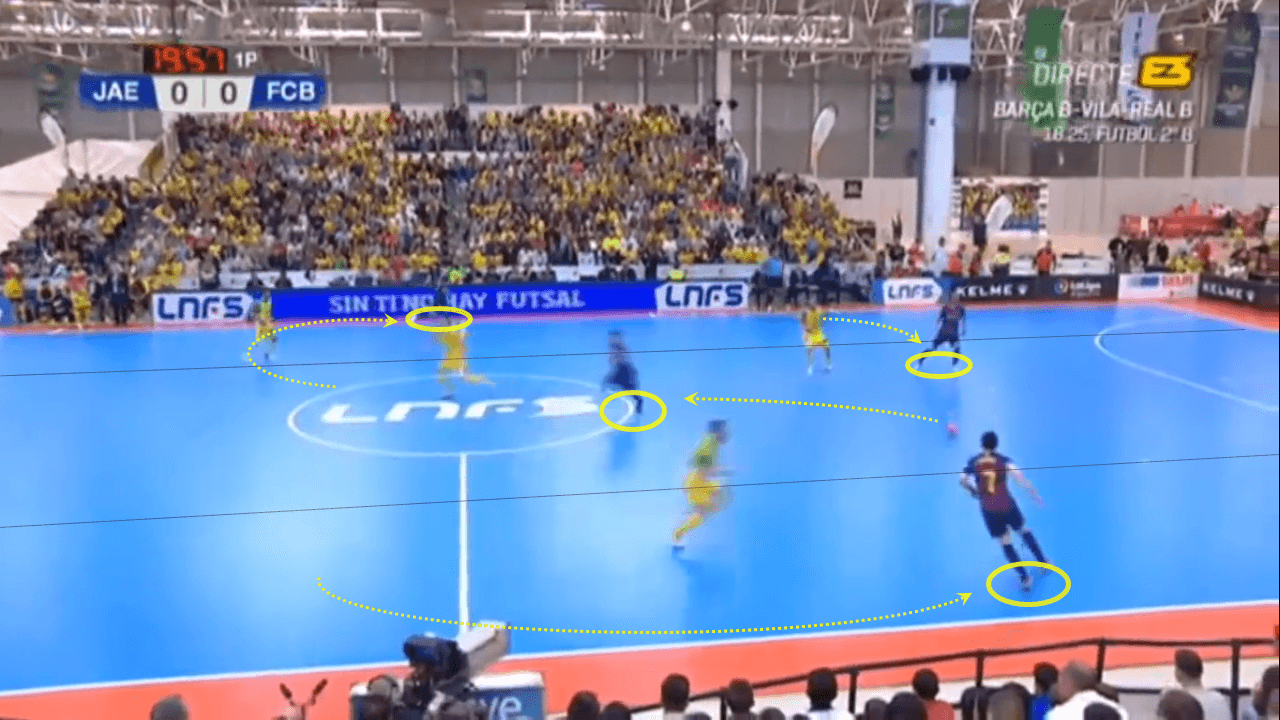
Most importantly, in futsal the boundaries of play are fixed, marked by the touchlines. In football however, the offside rule implies the boundaries of play are variable and is controlled by the defensive line of the opposition for any attacking team. This makes the spaces available to exploit highly variable and dynamic depending on team shapes and positions of players. Nevertheless we can borrow certain principles of rotations in futsal in certain parts of the pitch and phases of play to exploit space and disrupt defensive structures with constant movement. This clip from a Leeds United game demonstrates rotations used by Marcelo Bielsa.
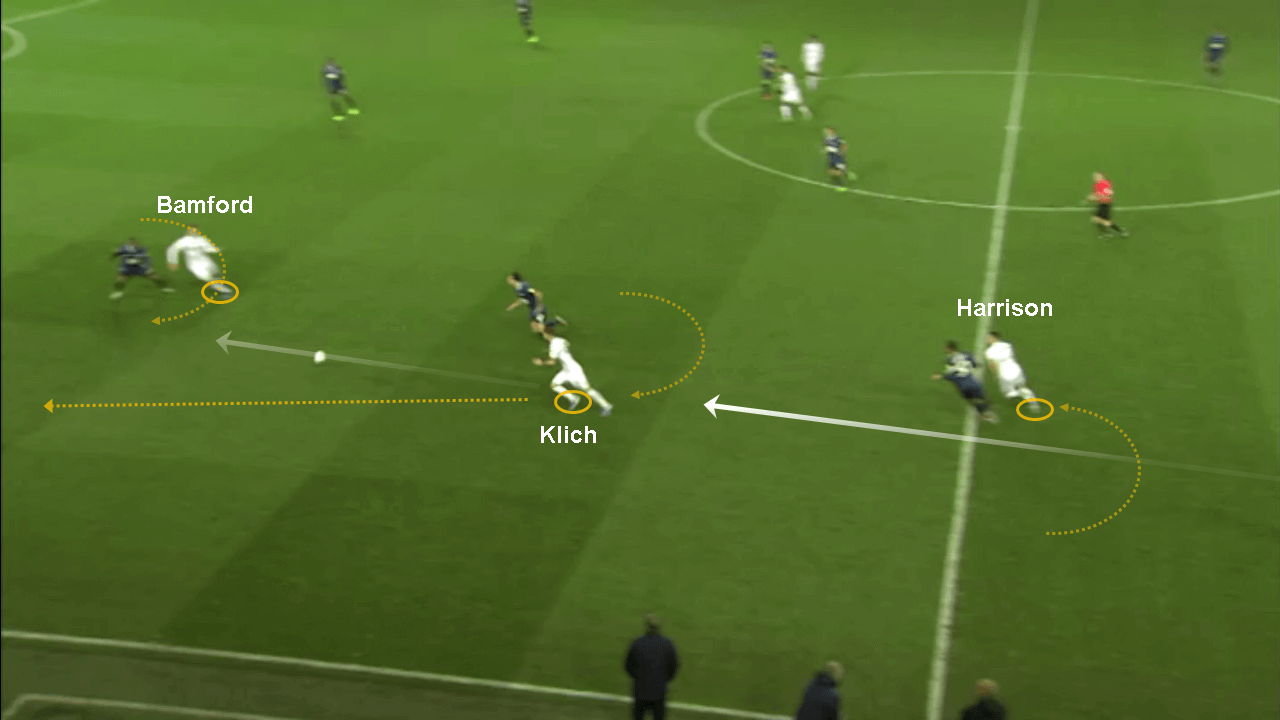
Concept of rotations in futsal
Rotations in futsal have evolved as an adaptation to the backpass rule. Once the keeper has played the ball to one of the players, only one backpass is allowed after the ball has crossed the halfway-line or has been touched by an opponent. This effectively means that the keeper can longer be involved in the build-up after playing the first pass out. The backpass rule in futsal ensures a scenario of numerical equality (4v4) in most phases of play, with an exception of a ‘powerplay’ phase when a team pushes their keeper into the opposition half making it 5v4 in a high-risk-high-reward situation. Rotations provide a means to find spaces against opponents that pressure high under conditions of numerical equality.
The four outfield players are the deep central player (Fixo), the left and right wingers and the high central player (Pivot). If we divide the futsal area of play into three zones vertically, the two wingers occupy the flanks each and the two central players are positioned in the central corridor in a diamond formation. The two common rotations in futsal are the 3-1 (involving three players with one fixed pivot) and the 4-0 (involving all four players).
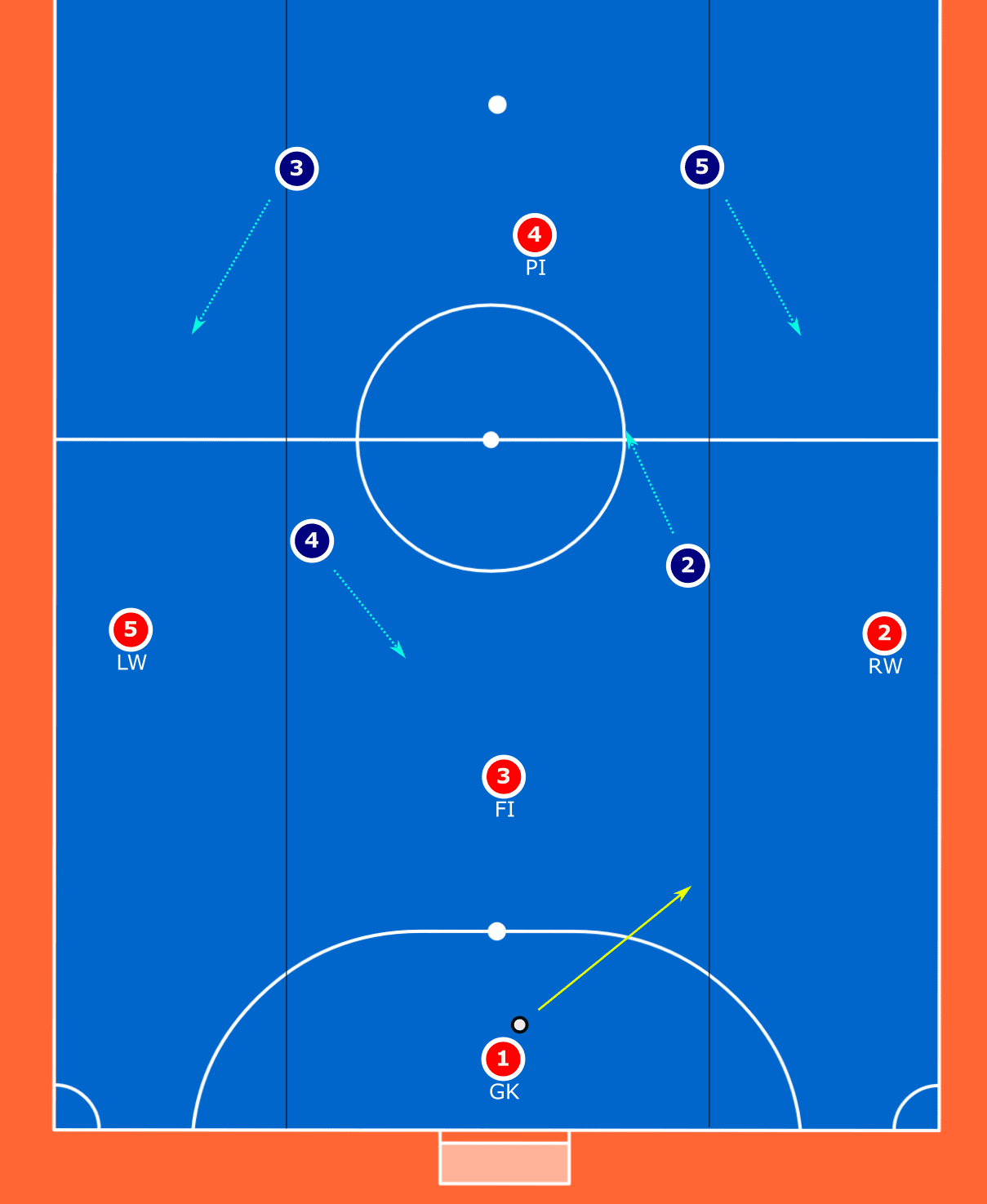
Let’s imagine a scenario where the team in possession (Red) shapes up as a diamond formation against a team (Blue) who are defending in a square. Once the red keeper has played out a pass he is no longer allowed to be part of the build-up in his half. Let’s assume the blues decide to engage in a man-oriented press to limit the time and space for the reds. The blues pick a red player each (shown by arrow directions) to mark all over the court.
Now let’s look at a 4-0 rotation. As a general principle, to maintain possession, the player in the central corridor releases the ball wide and pushes up, while the player in the flanks move lower to receive a pass from a player across the court and maintain circulation. So, the Fixo starts the move by passing left and moving up and into the left wing. The Left winger now finds the Right winger on the opposite flank, while the Pivot drops along the right wing. To explain this rotation, I have excluded the opponents for sake of simplicity.
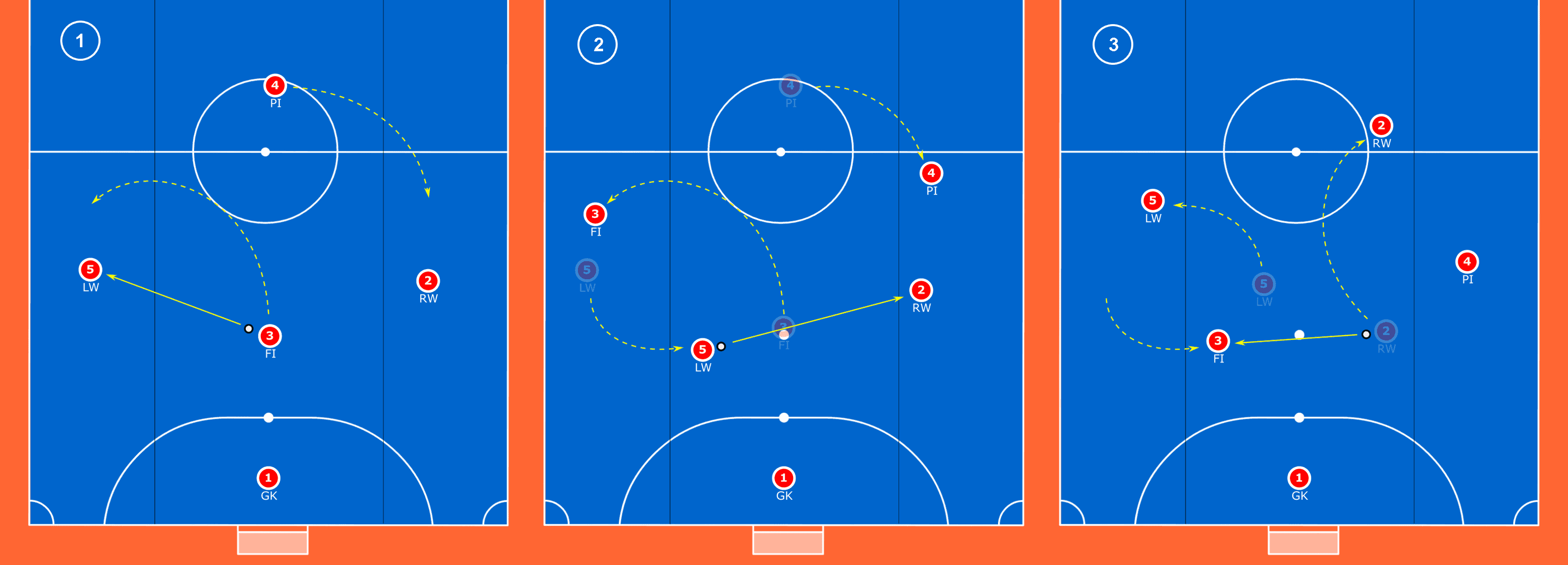
If we look at the position of the blue defenders now who are chasing their respective players, they are drawn out of position creating spaces for the reds to receive and find passing angles. An important aspect of this movement is that at every instant, the player in possession of the ball will have atleast two passing options for a brief window of time.
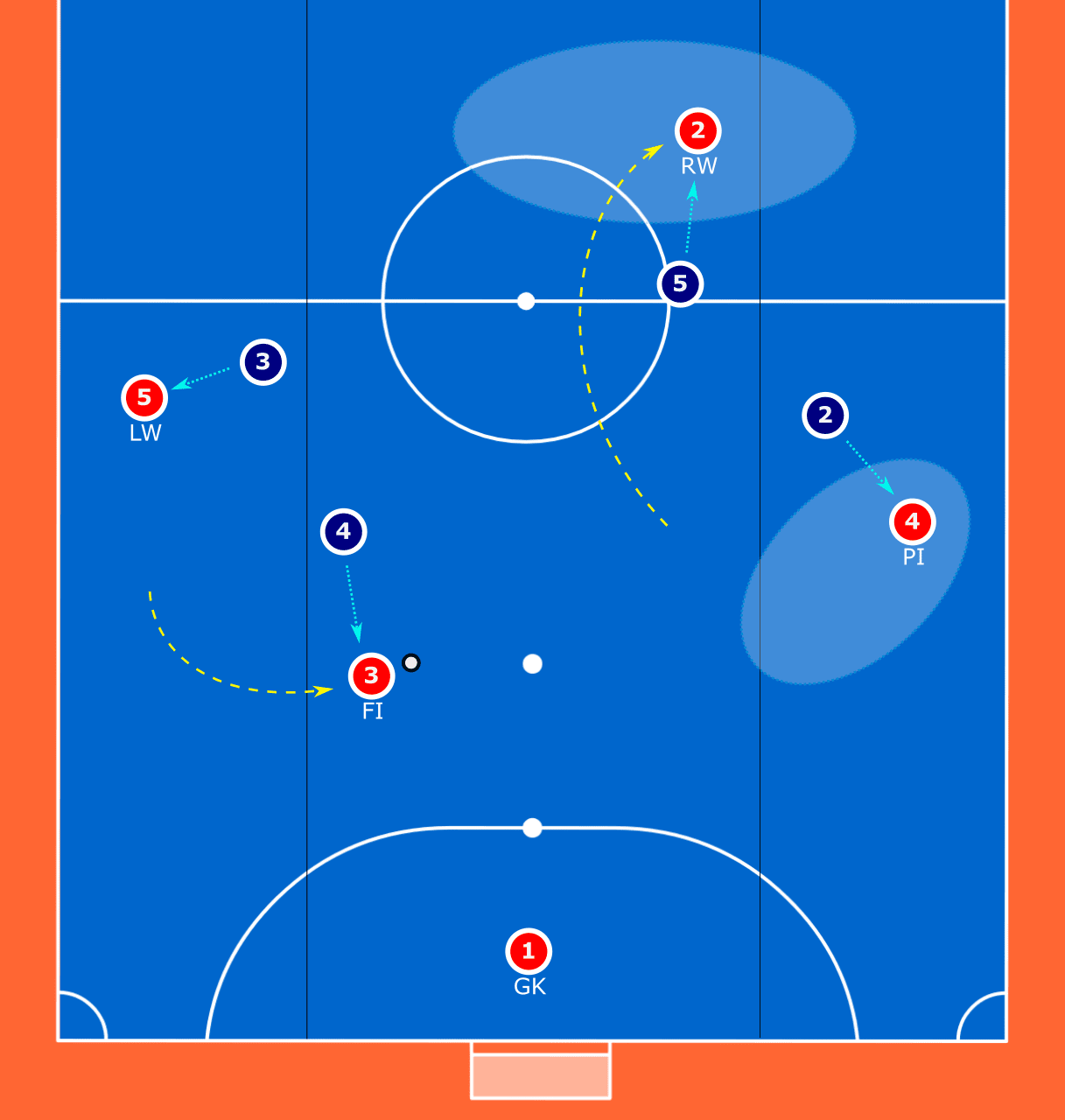
The first option for the reds is the safe one by the #3 to #4 to continue the 4-0 rotation and maintain possession. The second option is the more lucrative one, to find #2 who is pushing up centrally in the space behind the defence to create a 1v1 against the opposition keeper. Even if possession is lost, with an interception by the blue (#5), the reds will have the remaining three players behind the ball because of their rotations. The reds can keep circulating the ball patiently using this rotation until they find the right moment to penetrate or break the line of pressure.
The 4-0 rotation gives an idea of how players use positional movement to draw opponents and create space for themselves, even in a scenario of numerical equality. In the 4-0 rotation, two players continue rotating by staying on the same side, while in the 3-1 rotation, the players cross and move across the court after pushing up centrally. I won’t elaborate the 3-1 rotation, but to summarise, it involves using the Pivot stationed high while the remaining three players rotate to circulate the ball and look for an opportunity to play a pass forward to the Pivot.
Rotations in the midfield
The easiest way to envision how this rotation would work in football is the midfield triangle. Most formations such as the 4-3-3 utilise three central midfielders atleast one of whom plays the role of the holding midfielder. A defensive team often controls a lot of the opposition build-up by man-marking the holding midfielder and forcing the play out wide or tempting the attacking team to play the long ball. Rotations among the central midfielders can help create spaces and free passing lanes out from the back. Let’s see how we can replicate the futsal rotation in the hole in front of the defenders.
Let’s take a case of an attacking side (Red) lined up in a 4-3-3 formation against a defending side (Blue) structured as a 4-2-3-1. This is a classic match-up as the 4-2-3-1 uses two defensive midfielders to press the two attacking midfielders of the 4-3-3 while the number 10 can press the solo red holding midfielder (#6). The ball is in possession with the red centrehalf but there are currently no options to play out as all three midfielders are closely man-marked. To replicate this rotation we shall use three channels similar to futsal, namely the central corridor and the right and left half spaces.
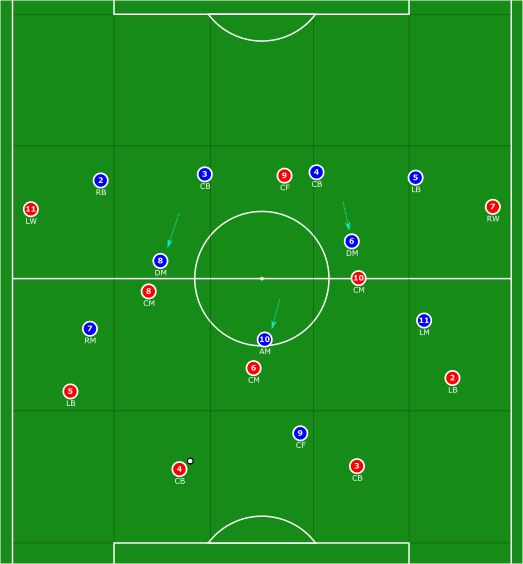
By using a rotation, the red #6 pushes up through the centre and drops back through the left half-space. The #8 drops deeper down the left half-space to receive the ball from the central defender. The #10 drops simultaneously as the #8 plays the pass to the #10 who is also closely marked. By now the #6 has completed the movement and returned back into the hole so that the #10 can play the pass back facing the same direction to the #6 who is free. The defending team’s shape hasn’t altered much but the attacking team has managed to find three successful passes and create spaces. For example, the space that the #6 dropped from can be now attacked by the wide winger for a free pass that breaks the line of pressure and helps the reds progress into the third stage of the build-up in the opposition half.
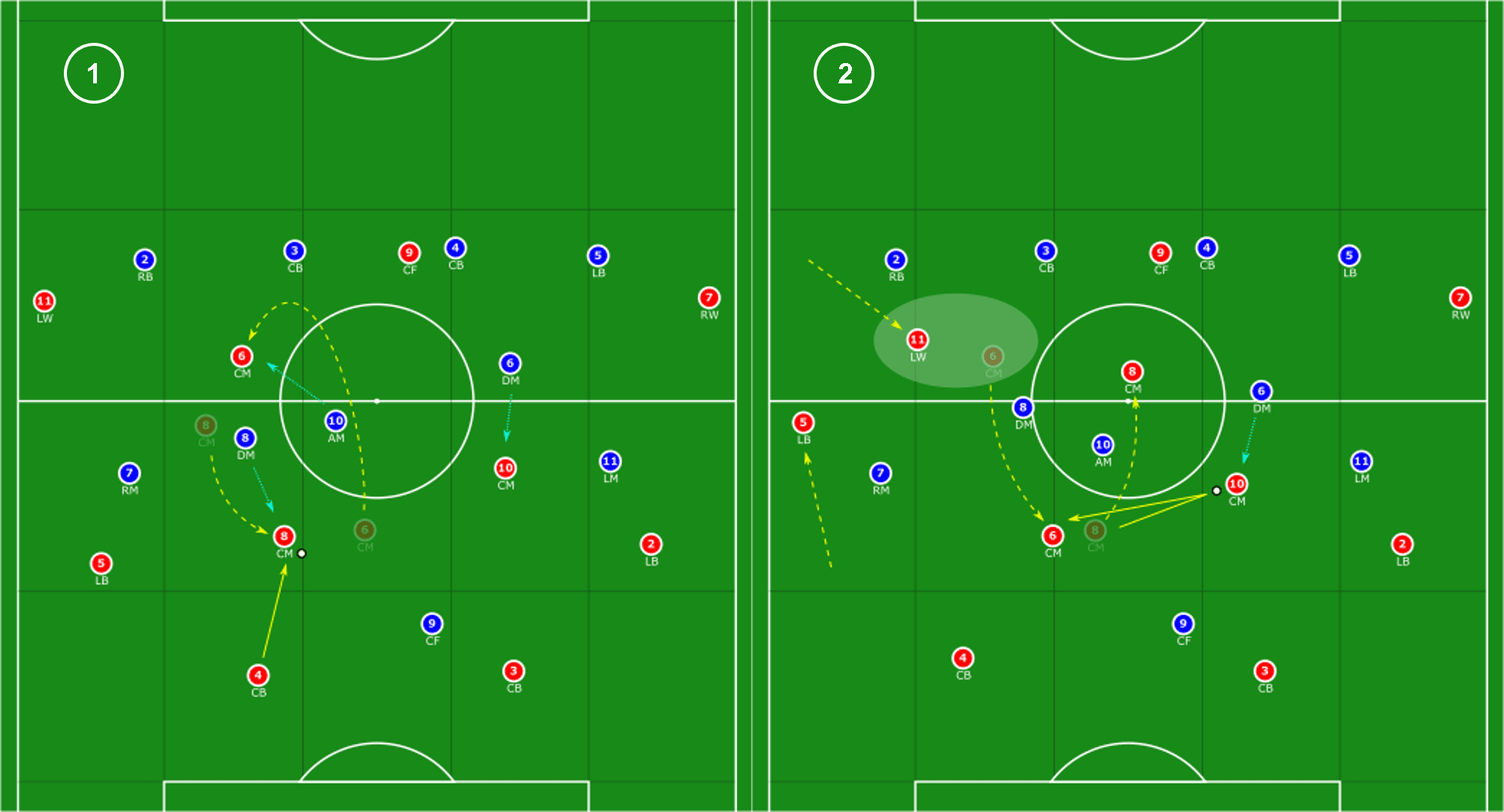
Rotations on the wings
Once the attacking team has entered the third stage of build-up in the opponent’s half, which is chance creation, it is necessary to maintain possession and use creativity in attempting to unlock a low-block defensive structure. If the defence manages to get bodies behind the ball and secure the spaces around their penalty box it becomes extremely difficult to find the free-man as we saw in Napoli’s defence in the first leg of the Champions League against Barcelona. Most attacking teams attempt to passively circulate the ball in a U-shape around the opponents without any real threat, a tactic detested by Pep Guardiola as elaborated in Pep Confidential.
In a situation where spaces are limited and opponents can easily create overloads with the numbers behind the ball, the futsal principles of rotations once again offer a solution. It is necessary to understand the three facets of establishing dominance on the wings: Width, Penetration and Cover. Width helps in pinning the opponent’s full back in place and a safe passing option with enough time and space. Penetrating runs push the defensive line back as defenders will take a step back for security and this gives the attacking team more room to work in. Cover offers support and balance and the option to switch play in case there is a risk of conceding possession.
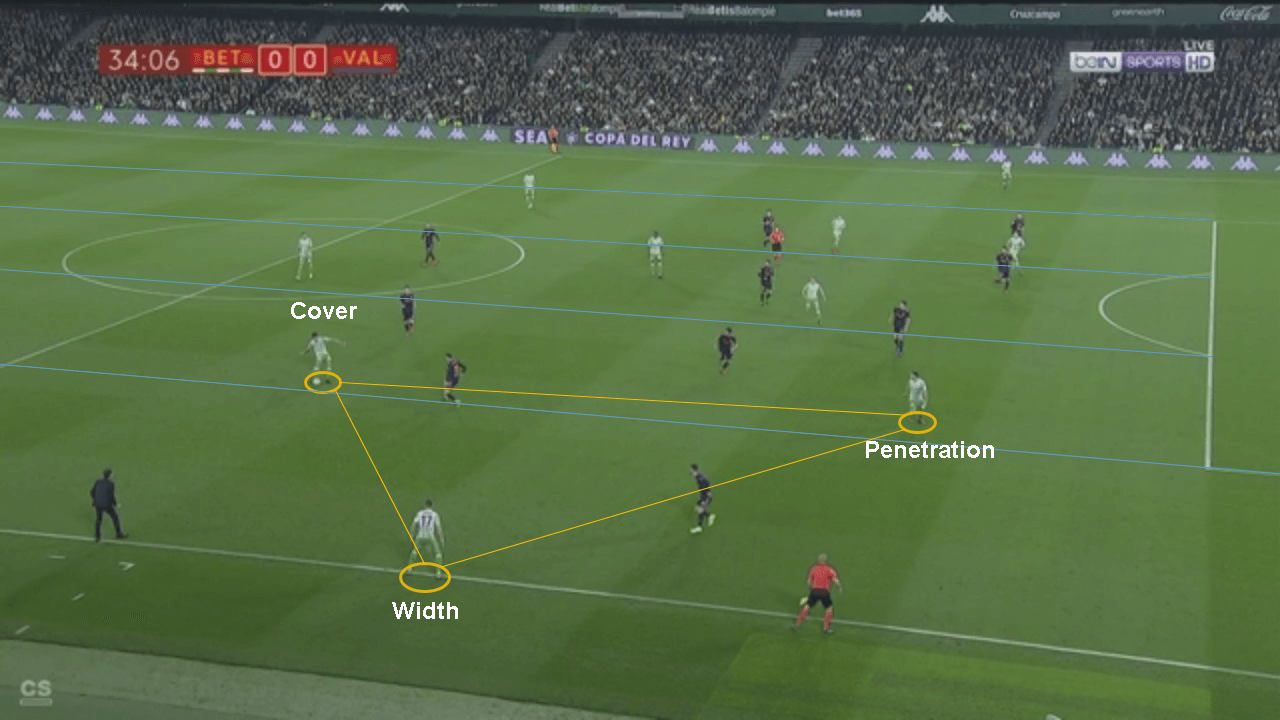
Now let’s go back to our tactic board with the blues collapsed into a 4-4-1-1 low-block to defend the reds who look to unlock the defence positionally. We shall focus on the play on the left side of the pitch with the ball in possession of the centre back (#4) who is well into the opposition half. We can see that it is a case of numerical equality as the blues defend deep and there are no free spaces yet. Using the futsal reference again we shall analyse how the reds attempt a rotation in the three channels – the left wing, the half-space and the central corridor.
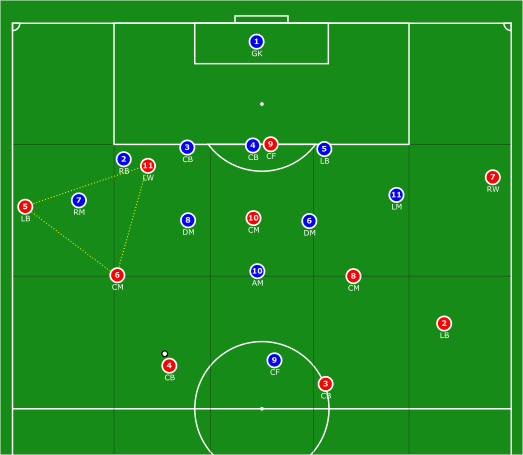
The #6 plays the ball wide to the left back (#5) offering width, while the left winger (#11) attacks the defensive line in the half-space to penetrate. The attacking midfielder (#10) from the central corridor drifts into the half-space to offer cover. Similar to the 4-0 rotation in futsal after releasing the ball wide, the #6 pushes up the half-space, while the #11 drops back along the left wing to offer new width to the reds while the #10 has become the new cover. The rotation continues similarly with the roles alternating and we see in the third sequence, like in futsal the player in possession of the ball has two options, a safe pass out wide to the left winger (#11) offering width or a penetrating pass to the full back who is pushing up the half space and attacking the defensive line. In case of any risk of conceding possession, the cover can turn and play the ball back or look to switch the point of attack to an underloaded part of the pitch.
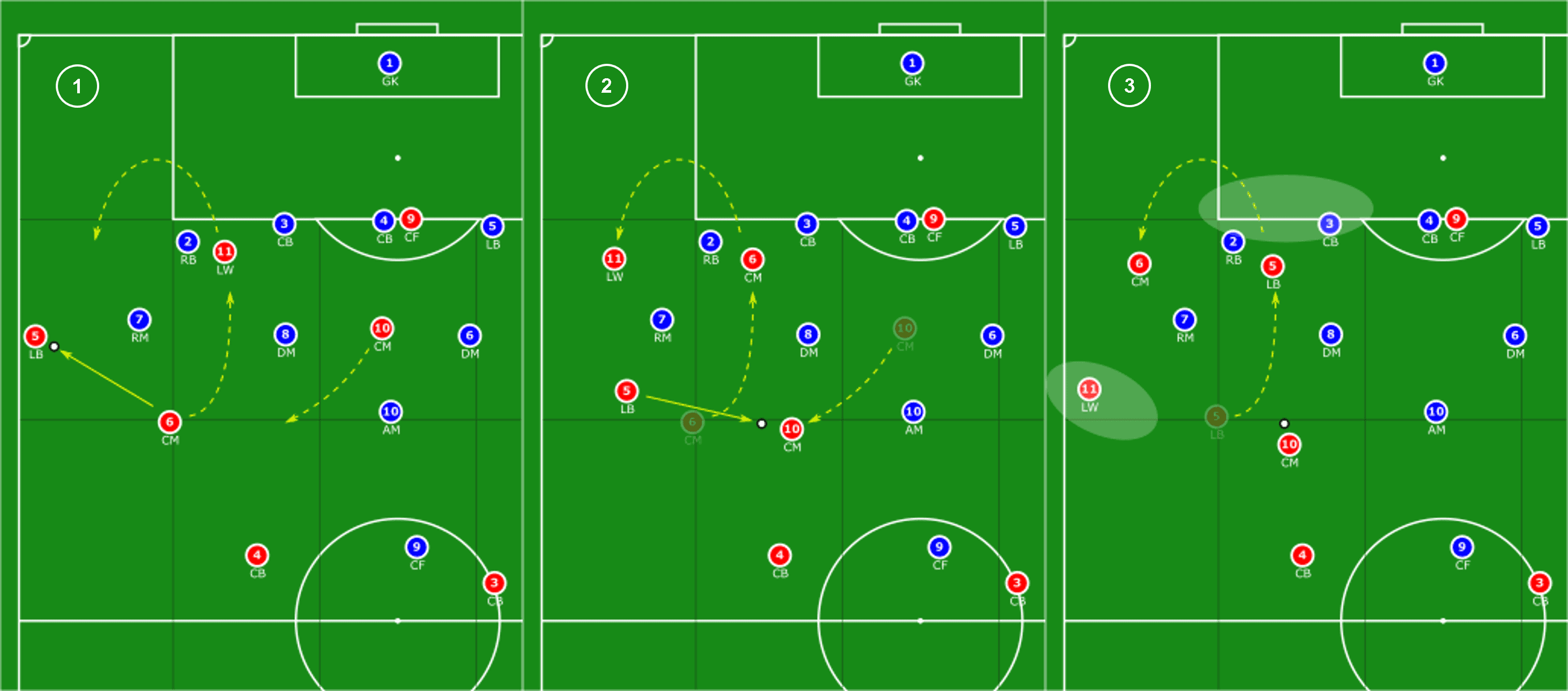
We often see these rotations in teams that engage in a positional game maintaining the fundamental principles of width, penetration and cover. Below we can see an actual team using rotations to maintain these fundamentals to create chances and progress into the final stage of the build-up which is the finishing stage in the penalty box. The rotations from futsal can be borrowed to create dynamic movements between players and find new spaces.
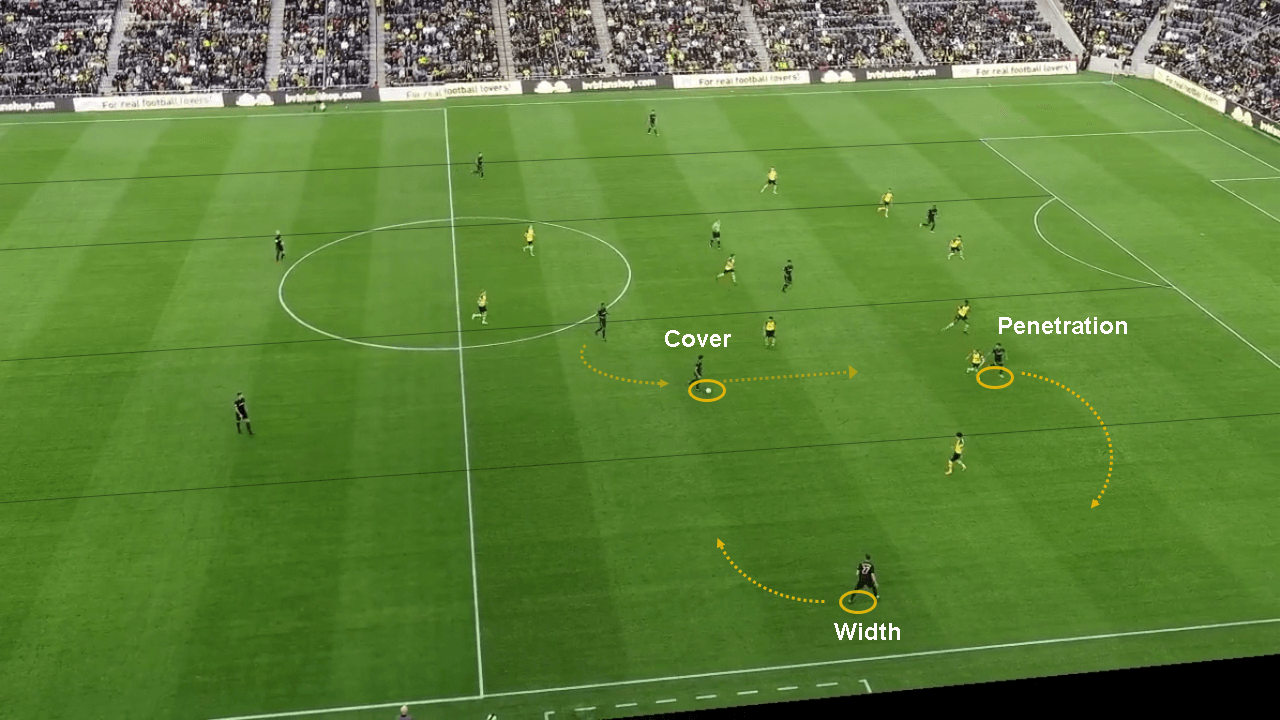
Rotations in the False-nine system
Once we understand how futsal rotations work, it is easy to see how the dynamics between three or four players can be established. In essence, certain parts of the pitch can resemble the three zones of a futsal court and rotations between players can help draw opponents out of position. The biggest proponent of this idea was Guardiola himself with his 2011-12 Barca side involving Lionel Messi, Andrés Iniesta, Xavi Hernández and Sergio Busquets.
We can see how a false-nine system would work if the centre forward engaged in 4-0 rotations with the three central midfielders. While one attacking midfielder (#8) pushes up along one corridor, the other (#10) drops along another corridor providing new passing options. If the centre forward (#9) drops into the midfield as part of the rotation, the left winger (#11) can attack the space from a wide area, prompting the left back to fill into the space left by the winger to maintain the width.
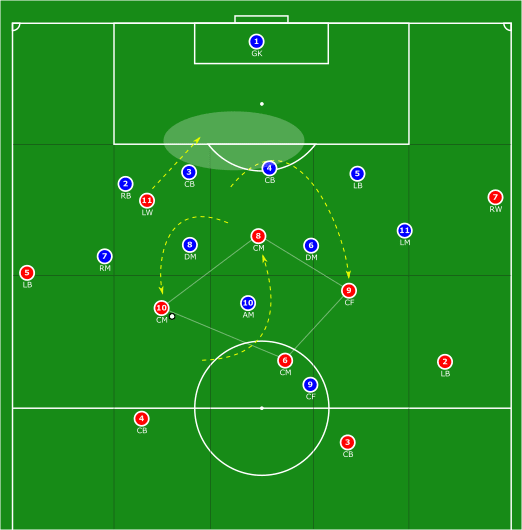
We have seen a lot of such similar rotations in the analysis of Pep’s Manchester City with Gabriel Jesus dropping into midfield and rotating with David Silva, Raheem Sterling or Bernardo Silva.
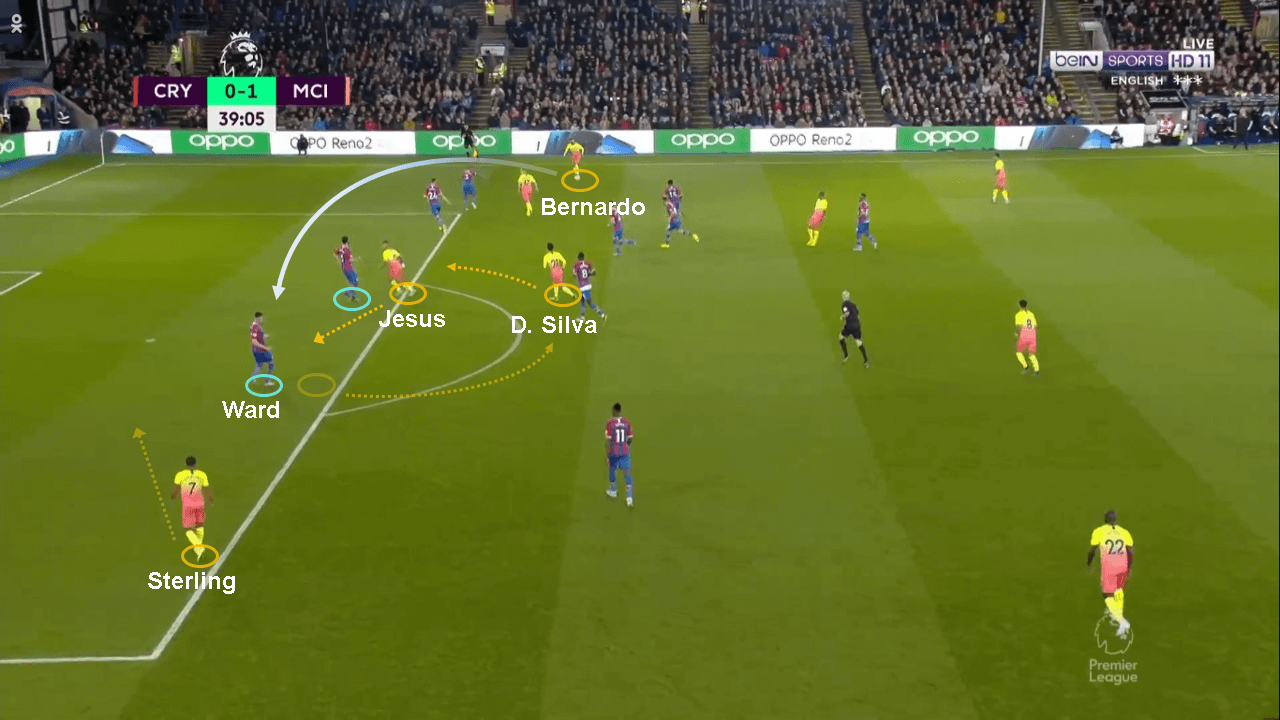
It was Guardiola who said:
“Futsal is like a square, a frame: diagonals and parallels are the basis of dialogue between players. In futsal there can be no difference between attack and defence, all players must interpret the two phases in the same way and the defence-attack transitions are constant and dizzying.”
A system that takes inspiration from futsal must adhere to its requirement that every player must be both an attacker and a defender, which is a crucial part of a false-nine system. The pressure must be applied immediately after losing possession and once possession is regained the objective is to advance forward using superiorities.
Conclusion
Cruyff’s statement of his ‘Dream Team’ from the 90s that “FC Barcelona play futsal on a big pitch,” is testament to how much the indoor format of the game played an influence on his game model. The roots of the positional game goes all the way back to Rinus Michels as Cruyff testified. Talking about their style at the time Cruyff said, “I think everyone should be able to play in all the different positions on the field.” He went on to say that “the special thing about the Dutch team is movement. Everyone moves. That’s the basis of it.” This also happens to be the foundations of futsal where constant movement and interchanging positions are used to find and create space.
Since then, a great number of coaches have adopted similar principles in their playing style with Guardiola perhaps achieving perfection with Barcelona in the 2011-12 season. A lot of players like Iniesta and Ronaldinho have attested their superior technical ability to foundations in futsal during their development. The England DNA Foundation Phase have incorporated the practice of shaping youth players through futsal, as has been a common practice in Brazil for decades after recognising the significance of futsal in breeding technical players with tactical nous and superior decision-making ability.
The fundamentals of futsal tactics align well with the principles of positional play and simple futsal rotations can be easily borrowed and implemented in specific parts of the bigger format. The game of futsal offers a fresh outlook on rotations, and coaching drills that incorporate futsal principles provide a competitive platform for understanding fundamentals of time, space and movement along with simultaneous attack, defence and positioning. I came up with these ideas as a consequence of coaching my team, Riga United FC Ladies who participate in the futsal tournament during the offseason in winter. However these are simply concepts and they could generate numerous ideas and possibilities to be applied in football.

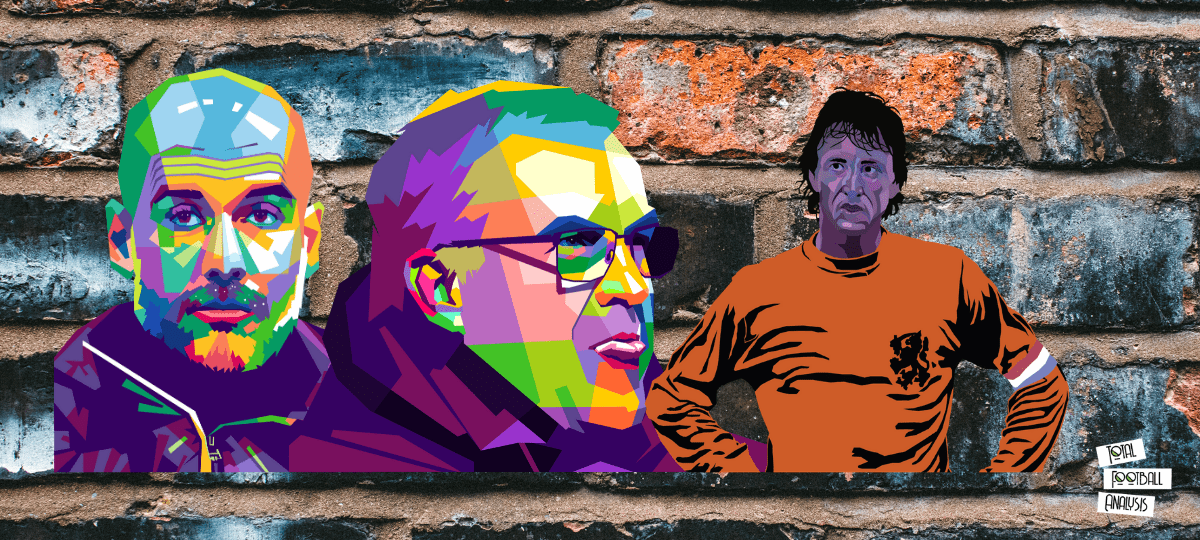


Comments